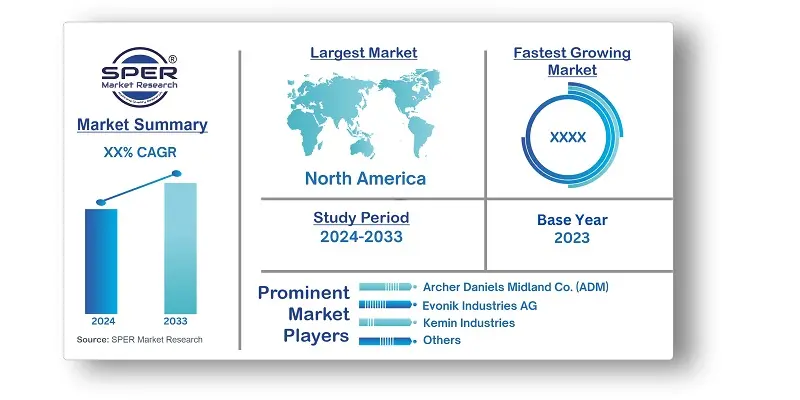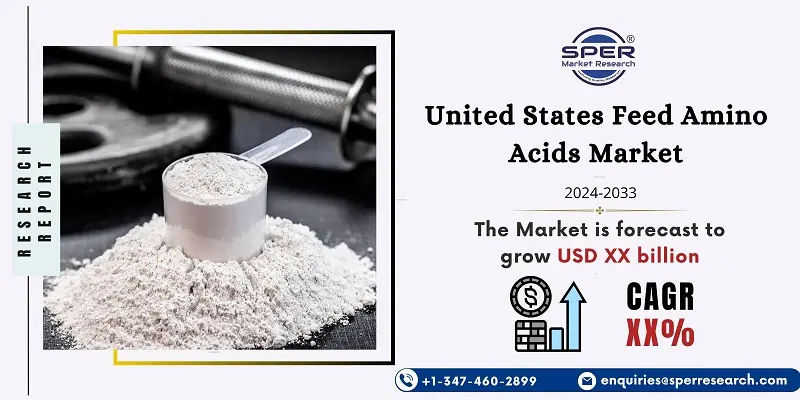
United States Feed Amino Acids Market Trends, Share, Size, Demand, Revenue and Future Outlook
United States Feed Amino Acids Market Growth, Size, Trends Analysis- By Type, By Livestock- Regional Outlook, Competitive Strategies and Segment Forecast to 2033
| Published: Nov-2024 | Report ID: FOOD24120 | Pages: 1 - 105 | Formats*: |
| Category : Food & Beverages | |||
- January 2023: Novus International, an international supplier for animal health and nutrition, purchased the biotech startup Agrivida. By way of the acquisition, Novus acquires ownership of the exclusive INTERUS technology that Agrivida created in order to incorporate feed additives in grain.


| Report Metric | Details |
| Market size available for years | 2020-2033 |
| Base year considered | 2023 |
| Forecast period | 2024-2033 |
| Segments covered | By Type, By Livestock. |
| Regions covered | Northeast, South, Midwest, West. |
| Companies Covered | Ajinomoto Co., Inc, Adisseo, Archer Daniel Midland Co., Evonik Industries Ag, Kemin Industries, Alltech, Inc, Land O’lakes, Novus International, Inc and Others. |
- Livestock and Poultry Farmers
- Feed Manufacturers
- Veterinarians and Animal Nutritionists
- Distributors and Suppliers of Feed Ingredients
- Agricultural and Animal Husbandry Associations
- Government Regulatory Bodies
- Research and Development Institutions
| By Type: | |
| By Livestock: |
- United States Feed Amino Acids Market Size (FY’2024-FY’2033)
- Overview of United States Feed Amino Acids Market
- Segmentation of United States Feed Amino Acids Market By Type (Lysine, Methionine, Threonine, Tryptophan, Others)
- Segmentation of United States Feed Amino Acids Market By Livestock (Poultry, Ruminants, Swine, Aquatic Animals, Others)
- Statistical Snap of United States Feed Amino Acids Market
- Expansion Analysis of United States Feed Amino Acids Market
- Problems and Obstacles in United States Feed Amino Acids Market
- Competitive Landscape in United States Feed Amino Acids Market
- Impact of COVID-19 and Demonetization on United States Feed Amino Acids Market
- Details on Current Investment in United States Feed Amino Acids Market
- Competitive Analysis of United States Feed Amino Acids Market
- Prominent Players in United States Feed Amino Acids Market
- SWOT Analysis of United States Feed Amino Acids Market
- United States Feed Amino Acids Market Future Outlook and Projections (FY’2024-FY’2033)
- Recommendations from Analyst
1.1. Scope of the report1.2. Market segment analysis
2.1. Research data source
2.1.1. Secondary Data2.1.2. Primary Data2.1.3. SPERs internal database2.1.4. Premium insight from KOLs
2.2. Market size estimation
2.2.1. Top-down and Bottom-up approach
2.3. Data triangulation
4.1. Driver, Restraint, Opportunity and Challenges analysis
4.1.1. Drivers4.1.2. Restraints4.1.3. Opportunities4.1.4. Challenges
4.2. COVID-19 Impacts of the United States Feed Amino Acids Market.
5.1. SWOT Analysis
5.1.1. Strengths5.1.2. Weaknesses5.1.3. Opportunities5.1.4. Threats
5.2. PESTEL Analysis
5.2.1. Political Landscape5.2.2. Economic Landscape5.2.3. Social Landscape5.2.4. Technological Landscape5.2.5. Environmental Landscape5.2.6. Legal Landscape
5.3. PORTERs Five Forces
5.3.1. Bargaining power of suppliers5.3.2. Bargaining power of buyers5.3.3. Threat of Substitute5.3.4. Threat of new entrant5.3.5. Competitive rivalry
5.4. Heat Map Analysis
6.1. United States Feed Amino Acids Market Manufacturing Base Distribution, Sales Area, Product Type6.2. Mergers & Acquisitions, Partnerships, Product Launch, and Collaboration in United States Feed Amino Acids Market
7.1. United States Feed Amino Acids Market Size, Share and Forecast, By Type, 2020-20267.2. United States Feed Amino Acids Market Size, Share and Forecast, By Type, 2027-20337.3. Lysine7.4. Methionine7.5. Threonine7.6. Tryptophan7.7. Others
8.1. United States Feed Amino Acids Market Size, Share and Forecast, By Livestock, 2020-20268.2. United States Feed Amino Acids Market Size, Share and Forecast, By Livestock, 2027-20338.3. Poultry8.4. Ruminants8.5. Swine8.6. Aquatic Animals8.7. Others
9.1. United States Feed Amino Acids Market Size and Market Share
10.1. United States Feed Amino Acids Market Size and Market Share By Region (2020-2026)10.2. United States Feed Amino Acids Market Size and Market Share By Region (2027-2033)10.3. Northeast10.4. South10.5. Midwest10.6. West
11.1. AJINOMOTO CO., INC
11.1.1. Company details11.1.2. Financial outlook11.1.3. Product summary11.1.4. Recent developments
11.2. ADISSEO
11.2.1. Company details11.2.2. Financial outlook11.2.3. Product summary11.2.4. Recent developments
11.3. ARCHER DANIEL MIDLAND CO
11.3.1. Company details11.3.2. Financial outlook11.3.3. Product summary11.3.4. Recent developments
11.4. EVONIK INDUSTRIES AG
11.4.1. Company details11.4.2. Financial outlook11.4.3. Product summary11.4.4. Recent developments
11.5. KEMIN INDUSTRIES
11.5.1. Company details11.5.2. Financial outlook11.5.3. Product summary11.5.4. Recent developments
11.6. ALLTECH, INC
11.6.1. Company details11.6.2. Financial outlook11.6.3. Product summary11.6.4. Recent developments
11.7. LAND OLAKES
11.7.1. Company details11.7.2. Financial outlook11.7.3. Product summary11.7.4. Recent developments
11.8. NOVUS INTERNATIONAL, INC
11.8.1. Company details11.8.2. Financial outlook11.8.3. Product summary11.8.4. Recent developments
11.9. OTHERS
SPER Market Research’s methodology uses great emphasis on primary research to ensure that the market intelligence insights are up to date, reliable and accurate. Primary interviews are done with players involved in each phase of a supply chain to analyze the market forecasting. The secondary research method is used to help you fully understand how the future markets and the spending patterns look likes.
The report is based on in-depth qualitative and quantitative analysis of the Product Market. The quantitative analysis involves the application of various projection and sampling techniques. The qualitative analysis involves primary interviews, surveys, and vendor briefings. The data gathered as a result of these processes are validated through experts opinion. Our research methodology entails an ideal mixture of primary and secondary initiatives.



Frequently Asked Questions About This Report
PLACE AN ORDER
Year End Discount
Sample Report
Pre-Purchase Inquiry
NEED CUSTOMIZATION?
Request CustomizationCALL OR EMAIL US
100% Secure Payment






Related Reports
Our Global Clients
Our data-driven insights have influenced the strategy of 200+ reputed companies across the globe.




















